Book reviews, Autumn 2013
OLIVER HIND AND THE 2ND NOTTINGHAM COMPANY OF THE BOYS BRIGADE by Terence Woolley
Terence Woolley Publications (2013) ISBN 978 0 9576599 0 2
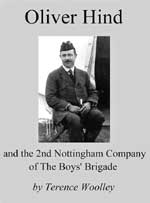
This timely book by Terence Woolley on one of Nottingham’s prominent 19th century philanthropists and the organisation he promoted and supported is a welcome account. Timely, because 2013 marks the 125th anniversary of one of the most significant organisations of the late 19th and early 20th centuries, the Boys Brigade, with which Hind was closely involved.
The BB, preceding by some years the Scouts, brought much valuable and valued teaching, structure and opportunities to generations of boys and young men.
The book commences with sections on the dire situation for children of the poor during the 18th, 19th and early 20th centuries and outlines some of the individuals and projects which aimed to better their lot. We learn about the beginnings of the BB in Glasgow in 1883 and its founder, William Alexander Smith. in 1888 the BB came to Nottingham with the formation of the 1st Nottingham Company.
Oliver Hind, a leading Nottingham solicitor, was one of those who had grave concerns about the young lads he saw in the city and he determined to try to do something to improve their lives.
In 1907 he established the Dakeyne Street Lads’ Club, renamed later to the Oliver Hind Boys’ Club. In his club Hind combined the ethos of the Boys’ Brigade with wide educational facilities, and established a centre of recreation and learning that enriched the lives of thousands of working class boys from the Sneinton area of the city over many decades. Eventually Dako, as it was popularly known, became the 2nd Nottingham Company of the Boys’ Brigade.
This book tells the story of Oliver Hind’s life and the unique boys’ club he founded and its association with the great Boys Brigade movement.
BC
WORKSOP THROUGH TIME by Sally Outram
Amberley Publishing (2013) ISBN 978 1 4456 1620 9 £14.99
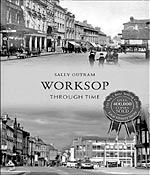
This book of 96 pages is another of the ‘then and now’ style with older images contrasted with current scenes. The author, Sally Outram, is a Nottinghamshire born freelance photographer working for the Retford Times with a passion for writing and photography.
Worksop is widely known as ‘The Gateway to the Dukeries’ and the town pre-dates the Norman Conquest. There is a rich and varied history in the town and, of course, it is adjacent to the ducal estates of Welbeck, Clumber and Rufford, all part of the ancient Sherwood Forest.
The images in this book provide a fascinating story of the changes which have occurred over time; some show greater changes than others and, of course, the earlier pictures are in monochrome (mostly sepia toned) whilst the later ones are in colour. Each set of images (set rather than pairs because some have small detail images inset) has an explanation and potted history of what is depicted. I like the fact that quite a few of the early pictures depict people, as in the Worksop Town football team (page 84), the Kilton Forest Golf Club (page 83), the Old Fire Stations (pages 65 and 68) and Kilton Hospital (page 60). However, a serious criticism of the captions is that the earlier images are rarely dated - an unfortunate omission which sadly devalues the whole point of the book.
This book will, however, appeal to residents of Worksop and its surrounding district but will also have an interest for others from further afeld. Useful for comparison with other towns of the county, the book will be of interest to all local historians, subject to the caveat of the undated photographs.
The book is obviously aimed at a general public rather than serious local historians but I can see no reason why both users could not be catered for by dating the interesting images contained within it.
HF
A CITY OF LIGHT: Socialism, Chartism and Co-operation - Nottingham 1844 by Christopher Richardson
Loaf on a Stick Press; ISBN 978-0-9569139-4-4 £7.99
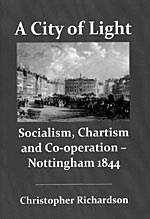
This is an A5 perfect bound book with soft covers, 243 pages and a few illustrations which is very reasonably priced and printed on paper from responsible sources.
I found the font used to be not very easy on the eye, possibly a point or two too large and because the margins are rather narrow it was not easy to read because the print curves away into the binding. In other words I found the presentation to be less than pleasing.
The book is very well researched, is excellently referenced with an extensive bibliography and index. Another excellent element is a map showing the positions of various places in Nottingham which are mentioned in the text although I would have preferred the map to be at the front of the book rather than placed at the back as appendix 5. There are 24 illustrations which are quite small and I feel could have been reproduced at a larger size for better effect.
These are, however, minor criticisms although a well printed and laid out book does add to the pleasure of reading it.
This book examines many original sources to illuminate and inform on the political situation in Nottingham in 1844 which was the time of the decline of Owenism and the turning to the land plan of the Chartist movement. It was a period of opposition to compulsory church rates and the New Poor Law. A period of the seeking of freedom of association, for a Worker’s Hall, libraries, Chartist Co-operation and the Chartist Co-operative Land Society. Christopher Richardson deals with all these aspects of the time in excellent detail. He sets the situation in Nottingham into the national and regional context which greatly aids the understanding of the local movements and agitations. The book considers the infuence of the Salford socialists on those in Nottingham, emigration in 1842 to establish communities in the USA (Illinois in particular), the treatment of Susannah Wright upon her return to Nottingham from Newgate prison, the Democratic Chapel (whose location is discussed without being definitely placed although suggests that it was previously known as Salem Chapel which had been a Primitive Baptist and Methodist chapel; there is a nice illustration of the building on Barker Gate on page 123) and the Operatives’ Hall Society.
Emma Martin’s expulsion from the Assembly Rooms is dealt with as is the Blidworth birthplace of Co-operation in England and the infuence on Co-operation in Nottingham of the Newcastle Chartists.
The book adds signifcantly to our knowledge of mid-19th century Nottingham and deserves a place on the book shelf of any Local Historian with an interest in the town and, indeed, for anyone with an interest in the history of the labour movements of the UK, of Chartism, Owen socialism, Co-operation and Feminism. It is highly recommended.
HF
IN SEARCH OF SCROOBY MANOR by Sue Allan:
Domtom Publishing Ltd. ISBN 978-1-906070-20-5
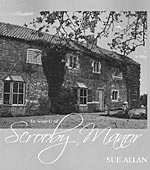
In search of Scrooby Manor is a beautifully illustrated 25 x 21cm soft backed publication of 108 pages that tells the story of an historic building. By her own admission, author Sue Allan might not be a trained historian, but together with the current owner of Scrooby Manor, she sets out to discover as much as possible about the building and its past, lending the book the enjoyable air of finding out, with the author, more about this historic building. The fact that she works as a guide to the Mayfower Pilgrim Trail gives her real authority and puts the research into historical context. Where the book succeeds as both a guide for the casual visitor and anyone more interested in Scrooby Manor is in its generous use of illustrations, plans and quotes from the period and from other historians. As she continues to delve into the history, they help her text come alive and give you a genuine feeling for a building that witnessed some of the pivotal events in history.
Allan uses a variety of historical sources, including the extensive research carried out by Dr. Henry Martyn Dexter of Massachusetts. Dexter investigated the site and its connection with the Pilgrim Fathers between 1851 and 1887. His son, Morton Dexter, published the research in 1906. Such is Allan’s understanding of the site that she is able to take issue with both Dexters and her questioning of their research helps throw more light on our understanding of the history of the building.
The most important aspect of the book is an inventory of Scrooby Manor 1536 and taken after Henry VIII’s separation from Rome. This helps give an impression of what Scrooby Manor may have looked like, and Allan’s excitement at seeing the inventory for the first time is almost palpable. Pictures of Gainsborough Old Hall, a similar property, are used to illustrate this section, and it creates a possible impression of the Manor during the sixteenth and seventeenth centuries.
Some genuinely interesting historical aspects are discovered by Allan’s research. In 2013 a section of oak roof beam from the existing Manor farmhouse was sent for dendrochronological dating, indicating that the tree it was cut from was calculated as growing in 1470. This proved invaluable in at least providing an indication of a date for part of Scrooby Manor.
Other chapters look at wider aspects of Scrooby’s history, from the key fgures that visited it to its role in the nascent postal system, but it is here that Allan’s grasp on the narrative starts to falter. Her focus frequently shifts, and the reader is catapulted backwards and forwards in time, almost at random. The author’s enthusiasm for the subject is hugely beguiling and one of her book’s strongest aspects, but allowed free reign, it asks too much of the reader and it is too easy to set the book aside wondering which point of the research you were in.
In Search of Scrooby Manor, for all that its narrative needs a touch less enthusiasm and slightly more cohesion, is a hugely welcome addition to our understanding of both place and period. Vital for anyone who plans to walk the Pilgrim Mayfower Trail, it should also be read by anyone with an interest in the period. As the author says in one memorably worked line, ‘The closest image to the truth will be the picture conjured up in the mind by each individual visitor’.
SHERWOOD FOREST AND THE DUKERIES: A COMPANION TO THE LAND OF ROBIN HOOD by Ian D. Rotherham;
Amberley Press. ISBN 978-1-1474-8
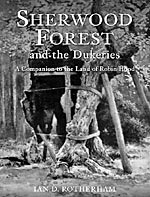
Internationally famous, if only by name and myth, Sherwood Forest is one of the county’s iconic areas. But it has often been a disappointment to visitors as the modern version of a forest is, for them, densely wooded. However, Sherwood Forest, a Royal Forest, was, as we know, never densely wooded. As the author of this new publication points out, the countryside and landscape of this area is infuenced by the underlying geology, creating many varied and diverse environments but ideal for royal hunting purposes. As we learn from this most useful and interesting book, Sherwood Forest was an extensive and expansive heathland, with wide open vistas and large numbers of giant oaks, open-grown trees widely spaced apart. The poor soil protected it over the generations from being turned to cultivation.
The book gives us an excellent introduction to forest laws, rights and courts and their purposes right up to the 20th century. The concept of ‘forest’ Professor Rotherham tells us, was brought to England by the Normans and was a continental legal system for the management of land, designed to protect hunting interests and resources of large tracts of land - ideal for the hunting mad Norman kings and nobles! It was the punitive Forest Laws that are often remembered: the Normans introduced these and they made life diffcult for Anglo-Saxons who were used to exploiting the resources of the surrounding land, treed and untreed, without too much hindrance from their Anglo-Saxon overlords. The author does point out that, though punishments could be cruel and unjust, cash-strapped kings (as they often were) were more interested in getting income from fines than inficting pain.
The book gives good coverage of the ducal estates which followed the break-up of the Royal Forest. Chapter three contains descriptions of the key houses and places of Sherwood and the Dukeries and includes some most interesting illustrations, mainly old photos. Chapters four and fve act as a gazetteer of the remarkable trees, many now lost, and of the Ducal buildings, again well illustrated by pictures of them in their heydays. The author also covers rural life and the impact of industrialisation on the area, especially of deep-coal mining.
For over two centuries the forest has been a major visitor attraction, with the ancient oaks much admired and now noted for their conservation importance. It is famous for the story of Robin Hood which has inspired story-tellers and flm makers alike and this book gives a realistic, but still romantic, view of this wonderful area. For us today, this book gives a round-up of places to visit - it is an excellent, readable history and guide book in one.
BC